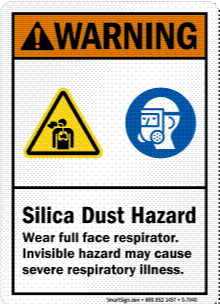
Silica: Exposure Control & Safety
According to OSHA, about 2.3 million people in the United States are exposed to silica at work. Workers who inhale these very small crystaline silica perticles are at increased risk of developing serious silica related diseases, such as lung cancer, copd, and kidney disease!
OSHA Standards
Due to the volume of identified cases of these diseases in occupations that are likely to produce silica containing dust, OSHA passed two new standards that are intended to better protect workers in the construction and general standards industry. Enforcement of the construction standards began on September 23, 2017 and enforcement of the general standards began on June 23, 2018.
These standards require employers to take steps to identify work tasks and environments that can potentially expose workers to airborne silica levels in excess of the OSHA Permissible Exposure Level of 50 micrograms of respirable crystalline silica per cubic meter of air. Some requirements of the standard come in to play when levels reach the "action level" of 25 micrograms per cubic meter.
What We Do
Our Certified Industrial Hygienist is equipped to provide specialized support in helping employers become compliant with the OSHA Crystalline Silica Standard. We assist in developing written Silican Exposure Control and Safety programs, conduct job hazard analysis and exposure assessments, collect personal and area samples for silica exposure to workers and ancillary personnel, conduct training to ensure workers are aware of the hazards with silica and how to protect themselves, and much more!